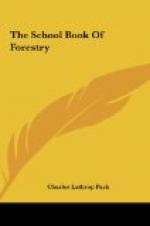During the fire season, extra forest guards are kept busy hunting for signs of smoke throughout the forests. The lookouts in their high towers, which overlook large areas of forest, watch constantly for smoke, and as soon as they locate signs of fire they notify the supervisor of the forest. Lookouts use special scientific instruments which enable them to locate the position of the fires from the smoke. At the supervisor’s headquarters and the ranger stations scattered through the forests, equipment, horses and automobiles are kept ready for instant use when a fire is reported. Telephone lines and radio sets are used to spread the news about fires that have broken out.
From five thousand to six thousand forest fires occur each year in the National Forests of our country. To show how efficient the forest rangers are in fighting fires, it is worthy of note that by their prompt actions, 80 per cent. of these fires are confined to areas of less than ten acres each, while only 20 per cent. spread over areas larger than ten acres. Lightning causes from 25 to 30 per cent. of the fires. The remaining 70 or 75 per cent. are classed as “man-caused fires,” which are set by campers, smokers, railroads, brush burners, sawmills and incendiaries. The total annual loss from forest fires in the Federal forests varies from a few hundred thousands of dollars in favorable years to several million in particularly bad fire seasons. During the last few years, due to efficient fire-fighting methods, the annual losses have been steadily reduced.
The best way of fighting forest fires is to prevent them. The forest officers do their best to reduce the chances for fire outbreak in the Government woodlands. They give away much dead timber that either has fallen or still is standing. Lumbermen who hold contracts to cut timber in the National Forest are required to pile and burn all the slashings. Dry grass is a serious fire menace. That is why grazing is encouraged in the forests. Rangers patrol the principal automobile roads to see that careless campers and tourists have not left burning campfires. Railroads are required to equip their locomotives with spark-arresters. They also are obliged to keep their rights of way free of material which burns readily. Spark-arresters are required also on logging engines.
The National and State Forests are posted with signs and notices asking the campers and tourists to be careful with campfires, tobacco and matches. Advertisements are run in newspapers, warning people to be careful so as not to set fire to the forests. Exhibits are made at fairs, shows, community meetings and similar gatherings, showing the dangers from forest fires and how these destructive conflagrations may be controlled. Every possible means is used to teach the public to respect and protect the forests.
[Illustration: Blackened Ruins of A fire-swept forest]




